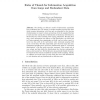Free Online Productivity Tools
i2Speak
i2Symbol
i2OCR
iTex2Img
iWeb2Print
iWeb2Shot
i2Type
iPdf2Split
iPdf2Merge
i2Bopomofo
i2Arabic
i2Style
i2Image
i2PDF
iLatex2Rtf
Sci2ools
CORR
2010
Springer
2010
Springer
Rules of Thumb for Information Acquisition from Large and Redundant Data
We develop an abstract model of information acquisition from redundant data. We assume a random sampling process from data which contain information with bias and are interested in the fraction of information we expect to learn as function of (i) the sampled fraction (recall) and (ii) varying bias of information (redundancy distributions). We develop two rules of thumb with varying robustness. We first show that, when information bias follows a Zipf distribution, the 80-20 rule or Pareto principle does surprisingly not hold, and we rather expect to learn less than 40% of the information when randomly sampling 20% of the overall data. We then analytically prove that for large data sets, randomized sampling from power-law distributions leads to "truncated distributions" with the same power-law exponent. This second rule is very robust and also holds for distributions that deviate substantially from a strict power law. We further give one particular family of powerlaw functions ...
Bias | CORR 2010 | Education | Information | Random Sampling Process |
Related Content
| Added | 22 Mar 2011 |
| Updated | 22 Mar 2011 |
| Type | Journal |
| Year | 2010 |
| Where | CORR |
| Authors | Wolfgang Gatterbauer |
Comments (0)

